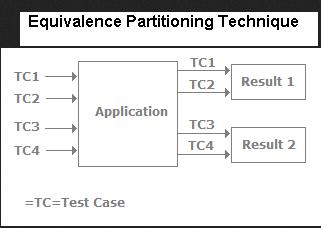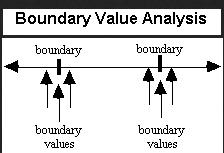Boundary value analysis and equivalence partitioning are the
testing techniques, so here we will introduces with the concept of these
techniques and their importance
We all know that exhausting testing is not logical and
possible because of limitation of time and budget. So we need to select those
most effective test cases which are able to find almost all the possible
defects.
So here we have these two techniques of testing Boundary
value analysis and Equivalence Partitioning:
Equivalence Partitioning Testing Technique: In this
technique test data will be divided into different -2 equal data classes. The main use of this technique is to reduce
the total numbers of test cases to definite set of test cases with covering
maximum requirements.
Mean – It is like a process which takes all possible
test cases and set them into classes. Test value will be picked from all
selected class during testing.
Equivalence Partitioning is a type of black box testing
technique which can be performed on all levels and types of testing like
system, integration, unit etc.
Live example: Tickets Behavior in the Flight
Reservation Application-
When passenger book new tickets then ticket value 1 to 10
are valid and will be booked but over booking will be treat as invalid booking.
i. So access values 11 to 99 will be considered invalid and
an error message will show “You can book 10 tickets at one time”.
ii. And If user will enter the value 100 or more than 100,
Then message will show “Invalid data, Please Enter the 2 digits number” or
number will take only first 2 digits as default.
iii. If customer enters value less than 0 or below the 0
then # of default tickets should be change to 1 automatically.
iv. So these test cases can be divided according to
Equivalence Partitions or the Equivalence classes. Then we can pick only one
value from the different partitions for such testing.
Main logic: The main logic behind this technique is
that if one value/condition will passed then it is assumed that other will also
pass. Mean if one condition of test cases in such techniques will fail then
other conditions in that conditions will definitely fail.
 |
| Equivalence Partitioning Technique |
Boundary Value analysis: In test case creation
process Boundary Value analysis is the next process after the Equivalence
partitioning where test cases are selected at the boundary of the equivalence
classes.
OR Simply Boundary Value Analysis test the edges between
equivalence classes.
We can also call it Range Checking technique to boundary
value analysis.
You can confirm properly and observe that you test values at
both valid and invalid boundaries.
Example: In this technique you will check the values
at the partitions like 0,1,10,11 and so on instead of one value of each
partition as our earlier example
Relationship in between boundary value and equivalence
partitioning: Boundary Value analysis and Equivalence partitioning both are
closely related to each other and can be use on all type of testing levels
together.
 |
| Boundary Value Analysis |
|
|
|
|
|
|
|
|
|
|
|
|
|
|
||
|
|
|
|
|
|
|
|
|
|
|
|
|
|
|
|
|
|
|
|
|
|
|
|
|
|
||
|
|
|
|
|
|
live example of boundary value analysis and equivalence
partitioning techniques, relationship in between boundary value and equivalence
partitioning, range checking technique.









No comments:
Post a Comment